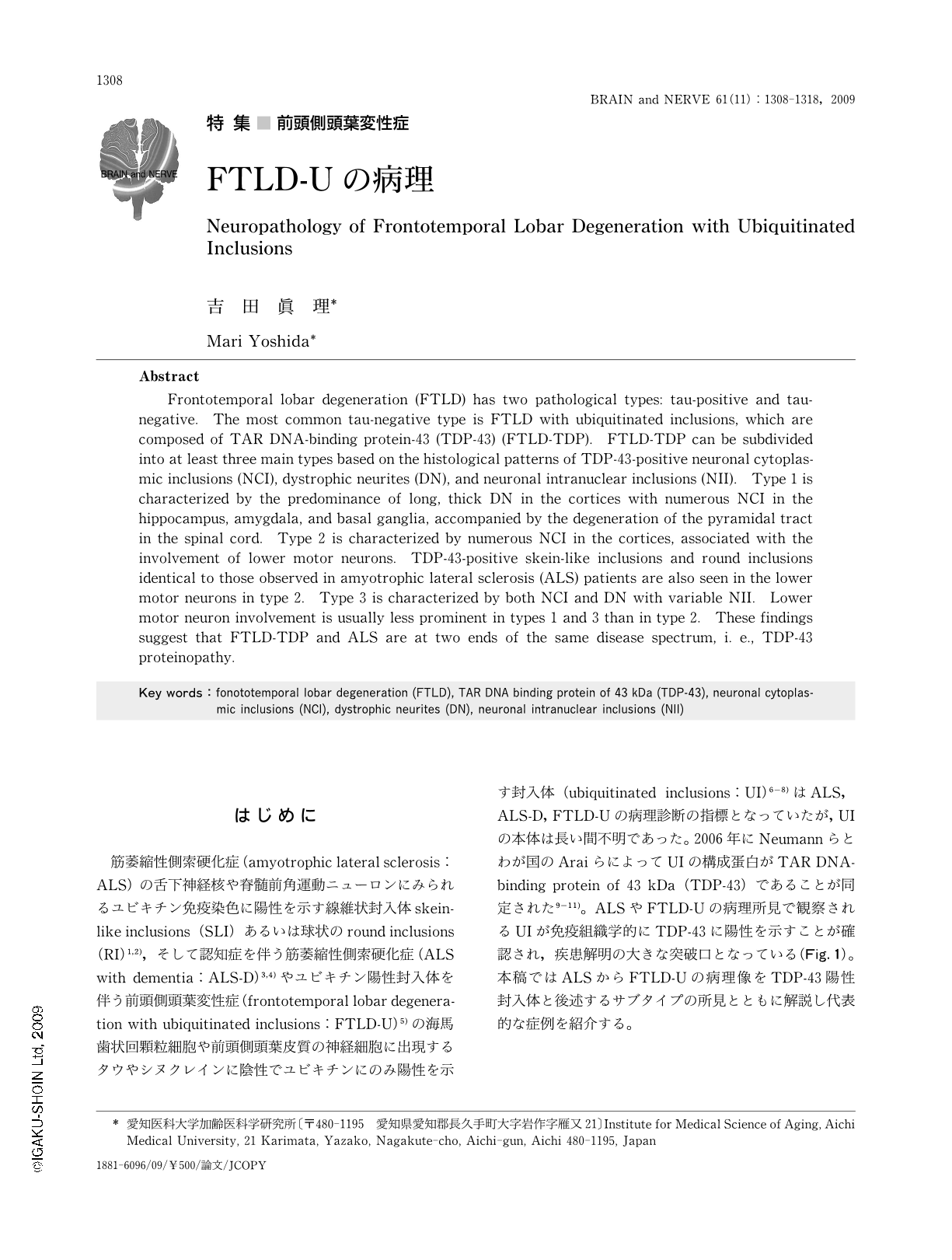Japanese
English
- 有料閲覧
- Abstract 文献概要
- 1ページ目 Look Inside
- 参考文献 Reference
はじめに
筋萎縮性側索硬化症(amyotrophic lateral sclerosis:ALS)の舌下神経核や脊髄前角運動ニューロンにみられるユビキチン免疫染色に陽性を示す線維状封入体skein-like inclusions(SLI)あるいは球状のround inclusions(RI)1,2),そして認知症を伴う筋萎縮性側索硬化症(ALS with dementia:ALS-D)3,4)やユビキチン陽性封入体を伴う前頭側頭葉変性症(frontotemporal lobar degeneration with ubiquitinated inclusions:FTLD-U)5)の海馬歯状回顆粒細胞や前頭側頭葉皮質の神経細胞に出現するタウやシヌクレインに陰性でユビキチンにのみ陽性を示す封入体(ubiquitinated inclusions:UI)6-8)はALS,ALS-D,FTLD-Uの病理診断の指標となっていたが,UIの本体は長い間不明であった。2006年にNeumannらとわが国のAraiらによってUIの構成蛋白がTAR DNA-binding protein of 43 kDa(TDP-43)であることが同定された9-11)。ALSやFTLD-Uの病理所見で観察されるUIが免疫組織学的にTDP-43に陽性を示すことが確認され,疾患解明の大きな突破口となっている(Fig.1)。本稿ではALSからFTLD-Uの病理像をTDP-43陽性封入体と後述するサブタイプの所見とともに解説し代表的な症例を紹介する。
Abstract
Frontotemporal lobar degeneration (FTLD) has two pathological types: tau-positive and tau-negative. The most common tau-negative type is FTLD with ubiquitinated inclusions,which are composed of TAR DNA-binding protein-43 (TDP-43) (FTLD-TDP). FTLD-TDP can be subdivided into at least three main types based on the histological patterns of TDP-43-positive neuronal cytoplasmic inclusions (NCI),dystrophic neurites (DN),and neuronal intranuclear inclusions (NII). Type 1 is characterized by the predominance of long,thick DN in the cortices with numerous NCI in the hippocampus,amygdala,and basal ganglia,accompanied by the degeneration of the pyramidal tract in the spinal cord. Type 2 is characterized by numerous NCI in the cortices,associated with the involvement of lower motor neurons. TDP-43-positive skein-like inclusions and round inclusions identical to those observed in amyotrophic lateral sclerosis (ALS) patients are also seen in the lower motor neurons in type 2. Type 3 is characterized by both NCI and DN with variable NII. Lower motor neuron involvement is usually less prominent in types 1 and 3 than in type 2. These findings suggest that FTLD-TDP and ALS are at two ends of the same disease spectrum,i. e.,TDP-43 proteinopathy.

Copyright © 2009, Igaku-Shoin Ltd. All rights reserved.


